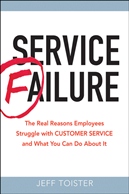Why customer service isn't always obvious
 Jeff Toister
Jeff Toister  Tuesday, April 12, 2011 at 12:40PM |
Tuesday, April 12, 2011 at 12:40PM | The video below contains a simple observation exercise. I encourage you to watch the short video before reading the rest of this post (it's less than 90 seconds long). (For my email readers, here's a link.)
Researchers Christopher Chabris and Daniel Simons found that only 50% of people notice the gorilla in the video the first time they watch it. Why? A strange phenomenon called inattentional blindness where our focus on one thing causes us to miss something that would otherwise be obvious.
I recently saw an example of this first hand when dining at one of my favorite local restaurants with my wife and her parents. The restaurant was very crowded so the only open table was tucked into a corner in the back of the restaurant. Unfortunately, we hardly saw our server after she took our orders. Our water glasses sat empty, we finished our meals before we had a chance to order a few cocktails, and she took a long time to bring our check. From our perspective, it was obvious that she should have paid more attention to us.
So, what could have gotten in the way? I observed a few things that may have caused her to unintentionally neglect our table.
-
Our table was tucked away behind a wall and out of sight from the rest of her section.
-
A large group was seated in her section just after we arrived and it was quite a production to take their orders, bring them drinks, etc.
-
Our server carried only one plate at a time in each hand, even when picking up dirty dishes, hinting at a lack of experience in restaurant service.
If you imagine we were out of sight on a busy evening with an inexperienced server who was trying to keep all her tables straight, you can understand why we might have been forgotten in the frenzy.
A great question to ask about your own employees is what might be distracting them from seeing obvious customer service opportunities?





